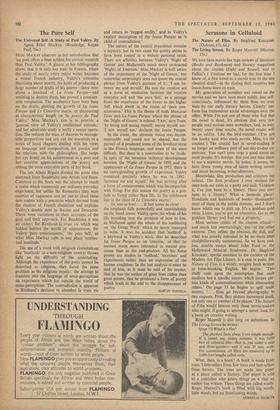The Living Screen. By Roger Manvell. (HarraP, 15s.)
WE now have movie-fan type reviews of literture (Books and Bookmen) and literary magazines about the cinema (Sight and Sound), and in Fellini's / Vitelloni we had, for the first time I know of, a first novel as a movie true to the last classical detail—in the closing shot, sensitive boy leaves home town on train My generation of novelists was raised on the movies and we have been more subtly, less self- consciously, influenced by them than we ever were by our early literary heroes. Clearly, one form has tremendous social advantages over the other. While I'm not one of those who feel that the novel is dead, it's obvious that very few people read serious ones nowadays;and, in only twenty years' time maybe, the novel reader will be an oddity. Like the bird-watcher. (I've got this kooky aunt who reads novels. Man, it's the craziest!) The crucial fact is novel-reading is no longer an ordinary part of our day-to-day ex- perience. You can't even urge a good novel on most people. It's foreign. But you can take them to see a superior movie. So today, it seems, we have fewer young men of talent writing novels and more becoming writer-directors.
Meanwhile, film production and criticism lag behind. The first producer I ever worked for once took me aside at a party and said: `Goddam it, I've just been to a library. Have you ever been to a library? What a fantastic place! Hundreds and hundreds of books—thousands! most of them in the public domain, and I don't know which one to pick up. It's a goddam gold mine. Listen, you've got an education. Go to the goddam library and find me a property.'
Most serious critics of the cinema offend— and much less entertainingly, too—at the other extreme. They inflate the obvious, the dull, and what was usually intended to be no more than straightforwardly commercial. So we have end- less, erudite essays about John Ford or the Hollywood Musical Syndrome. Dr. Siegfried Kracauer, special assistant to the curator of the Modern Art Film Library, is a case in point. His Nature of Film is a windy, weighty book written in bone-breaking English. He begins: 'This study rests upon the assumption that each medium has a specific nature which invites cer- tain kinds of communications while obstructing others.' On page 33 he begins to spill trade secrets; `. . films go beyond photography in two respects. First, they picture movement itself, not only one or another of its phases.' The Nature of Film would interest only those movie-makers who might, if going to attempt a novel, look for a book on creative writing.
Roger Manvell is also long on definitions. In The Living Screen he writes :
(page 13) What is a film?
The physical facts about it are simple enough.
If it lasted, say, ninety minutes, it was 9,000 feet of celluloid film—that is, just under a mile and three-quarters—and it was 35 mm. wide. For convenience, all films are measured up jO 1,000-foot lengths called reels.
What, then, is a book? A book is made from trees. Little-sellers from few trees and best-sellers from forests. The trees are made into paper at a place called a factory. The paper is sold to a publisher who prints things on it that an author has written. These things are called words. Roger Manvell's book is filled with big words, little words, but no illuminating words.
MORDECAI RICHLER


































 Previous page
Previous page